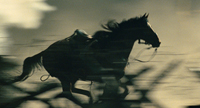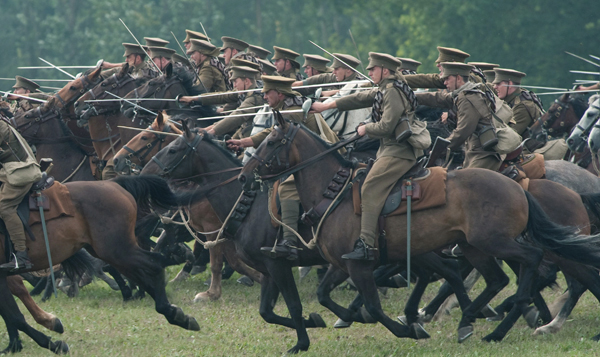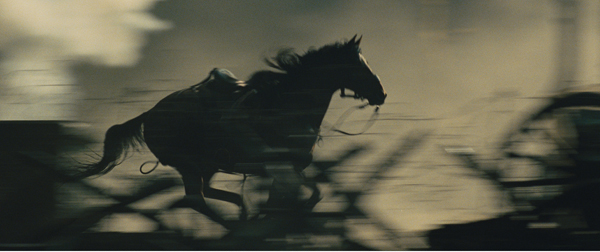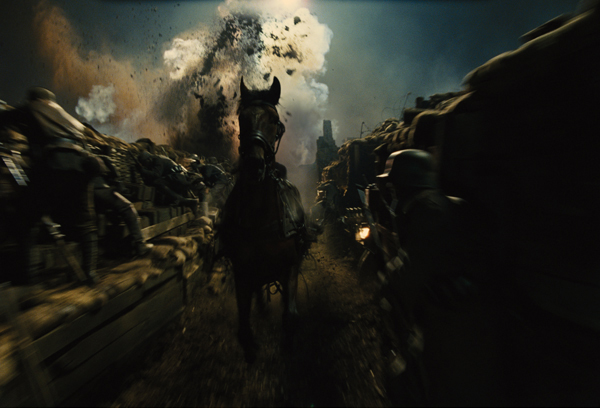
VFX supervisor Ben Morris leads the Framestore team to create invisible effects, 3D CG and
animation for Steven Speilberg’s romantic film ‘War Horse’ about a heroic young boy and his
horse Joey who together survive the violence of WW1.
 |
|
| Production Designer Rick Carter and Producer Kathy Kennedy approached Framestore in early 2010 by to discuss working on ‘War Horse’, Steven Spielberg’s next film. The story was already a running as a successful stage play in London’s West End by then, produced with tremendous puppet performances for the animal characters.
During pre-production, the production and Framestore established that the project would need a range of visual effects from paint cleanup to full digital horses but was essential that the work should never be visible. Detailed Previs |
|
 |
|
| As soon as Rick Carter arrived in the UK, Framestore’s in-house art director Kevin Jenkins started on the concepts for critical VFX moments in the film. As Rick got more familiar with Kevin's work, he invited him to join the Production Art Department at Long Cross Studios where Kevin spent the next four months conceptualising and designing many parts of the project, including some non-VFX sequences.
Ben and his team from Framestore were in Devon shooting for three weeks. The VFX team were on-set every day of shooting. Ben and Steven Spielberg would discuss all possible options for achieving shots in-camera or with fairly simple VFX. Steven tended to prefer more traditional and, in some cases, more time-consuming techniques such as multi-pass crowd replications instead of immediately turning to CG. Ben said, “I think this approach really pays off in the film, as these shots naturally have a level realism that is in keeping with the rest of the film.” In-Camera Battles Shooting the battle sequences with Steven and DP Janusz Kaminski was especially exciting. “As planned, the daylight trench attack sequence is almost completely in-camera with practical stunt and SFX work supervised by Rob Inch and Neil Corbould,” said Ben. “We enhanced the expansive No Man's Land set in a few shots, extending the deep background with further trench landscapes, burnt trees and smoke elements. We also added gun muzzle flashes in numerous shots.” |
|
 |
|
| On the Farm While shooting in Devon, the weather constantly changed dramatically. They experienced blazing sunshine, torrential rain, thick fog, freezing cold mornings - sometimes all in the course of a single day. Devon's landscapes required very little VFX enhancement aside from paint-outs of modern day elements and even the spectacular sunsets at the end of the film were real. “While shooting at Narracott Farm we did get involved in the scene involving Joey and Albert ploughing the barren field near the farmhouse. For safety the plough that Joey pulls often had a cabled winch system attached to it for shots showing it actually cutting the soil. The cleanup work was mostly 2D based but some of it involved complex occlusion of Albert, Joey, the plough and the cut furrows of soil. The compositors often had to patch through their fixes with many layers of projected texture using 3D camera tracks, working in Nuke and Silhouette. For wider shots we also painted out horse wranglers, harnesses, rain stands and added rain elements,” Ben said. A shot of Harold, a goose, chasing intruders from the farmhouse was harder than expected when the trained goose failed to perform. For the main shoot, the actors performed the scene without the goose, and then Ben’s team returned to the same location a few days later and managed to capture shots of the goose chasing his trainer running towards the gate. Without motion control passes, both shots were tracked in Nuke and the separate plates of the actors and goose were then aligned to create the final shot. |
|
 |
|
| Cavalry Charge The tragic British Cavalry Charge was a significant VFX sequence involving VFX. “For this we had to extend a small practical reed bed used to hide the British Cavalry with hundreds of 2D reed elements we shot against bluescreen on location. There was no practical way of using chroma screens to help separate the foreground horses and riders from the background, so we resorted to a lot of roto to integrate our reeds into the shots. The 2D cards were placed in Nuke using a particle system devised by Chris Zeh our compositing supervisor on the project,” Ben said. “We also shot several multi-pass shots to extend the 80 Cavalry available each day to more than 300 in the wider shots. With fast moving clouds under direct sunlight through the shoot period, the compositing team had to carefully balance the different passes to create seamless shots for the film.” As the British Cavalry approach the German line at the edge of the forest they suddenly realise their mistake and are killed by a hidden line of machine guns. Steven had decided to not to show riders and horses being gunned down and preferred to use shots of riderless horses, jumping over German gun positions, to tell the story. Framestore’s team worked with the horse trainers and the stunt team to build a system of horse lanes with posts and tape to resemble electrical fencing. It safely prevented the free-running horses from straying off course, but needed weeks of painstaking frame-by-frame paint work in post for the five or six shots in the sequence. Because the production wasn’t allowed to fire the machine guns during shots with real horses, Framestore added smoke and muzzle flashes using 2D elements shot later on. The team learned that the machine guns used in the film were real German guns from WW1, possibly used in action. Ben said, “At the end of the sequence a crane shot pulls back to reveal the devastation caused to the British Cavalry during the attack. For this shot we extended the numerous practical dead soldiers, horses and burning camp with 2.5D matte painting.” |
|
 |
|
| Cannon Fire For a shot of two German boys being executed after deserting their company, Steven staged the action outside the windmill they had been hiding in. “This allowed us to conceal the actual moment of death behind a slowly rotating sail. In order to give us maximum control in post we filmed the boys being shot 'clean' and then shot foreground elements of the rotating sails which we then re-timed in the composite to get exactly the action Steven was after,” said Ben. “We also had to open a few holes in the practical sail element to allow us to see the rifle muzzle flashes as they fire.” In many shots of Joey and Topthorn, another horse, pulling a heavy cannon up the hill, the artists had to paint out a large winch system used to pull the practical cannon. As the horses get to the top of the hill Steven wanted to reveal the true horror and scale of the devastation caused by the trench warfare in WW1. “For this shot we filmed two practical cannons firing from two different camera positions at the same location in Bourne Wood, giving us plates to build the final shot of four cannons firing over the vast battle landscape,” Ben explained. “In post we had to separate the cannon plates into individual cannons for timing purposes, compounding the complex extraction of practical smoke from the forested background in the original plates. "Working from a concept design by Kevin Jenkins, the matte painters Dave Early and Joseph McLamb painted the expansive battleground of devastated towns, roads and rivers for the comp team to integrate with the foreground plates and layers of smoke and fire. Steven wanted to see the foreground cannons firing and sustain the shot to show the massive distant explosions of the shells landing on the horizon. Rather than generating CG explosions we shot a series of high-speed, practical explosion elements and composited them into the shot.” |
|
 |
|
| No Escape In a dramatic sequence, Joey is chased by a British tank into a blocked road system with no escape route. SFX supervisor Neil Corbould built a full scale practical tank, with hydraulic track motors, guns and steel armour. In order to safely shoot real horses close to the practical tank, trainers needed removing from shots or separate elements had to be re-timed within the plates to create a believable feeling of danger to the horse. Joey finally makes a heroic escape by jumping over the tank. They tried to shoot the action with real horse stunts performed in-camera over a stationary tank covered in flat safety rostrums, and shot several different versions over a number of days. But Steven decided that shots look too static, and wanted the tank to keep moving. When time ran short they finally opted to use a CG horse to achieve the shots. The artists used synchronised, multi-camera photogrammetry data and a flat lit texture shoot to model and paint the CG horse based on a combination of the two 'hero' horses who played Joey in the film. The cannon harness and tack Joey wore was modelled from photographs. Modelling tools were Mudbox and ZBrush, with Mari and Photoshop for texturing. CG supervisor, Mike Mullholland handled the horse build and rig, using in-house tools to create underlying skin and muscle movement. To light and render the model, hair and short fur Framestore’s PRMan shader library and fur system were used. Lighting reference for the shots was based on HDR environment maps captured on-set using a Canon 5D, 8mm Sigma fisheye lens and Promote Controller. The final lighting and renders with multiple AOV's were rendered in PRMan and brought together in Nuke. Over the Trenches The start of the action was shot as an empty plate into which we would comp a 2D element of a real horse. The master plate camera was mounted on the back of a quad bike with a remote stabilised head. As soon as the operator made his reaction and pan from right-to-left, the quad started its high-speed run down the occupied trench. “At just the right moment we signalled for a horse ridden by a grey suited stunt rider to start its run along the left edge of the trench. After a few rehearsals, we managed to reveal the horse and rider as the quad bike hit full speed down the trench,” said Ben. “Then an SFX rigged practical shell explodes directly in front of the horse and rider, causing it to react naturally and ride safely out of shot. At this point the camera panned right following a non-existent horse to meet practically rigged sandbags which fell into the trench as if a horse had hit them. The plate ended revealing the 'empty' bottom of the trench with a group of German soldiers looking on in surprise.” Once the A plate was captured, the camera was mounted on sticks in the position the quad bike had stopped at, where a different horse was trained to get up from a lying position on command and gallop off down the trench. Alignment Issues “The trackers also calibrated an array of witness cameras we used while shooting the sequence – three HD cameras, genlocked to the 'hero' film cameras and two free-running Arri 435's, just to be safe. As soon as the witness array was calibrated we started body tracking the entire run down the edge of the trench to the point where we would transition to a CG horse after the explosion.” For camera tracking they might use 3DE, Matchmove, boujou or Nuke, depending on the shot. Once they started to animate the horse in Maya, jumping, falling, they decided they would need to retime and re-rack the camera move to create a realistic horse animation, continuously updating the scene with refined body tracks and camera moves. Once the animation was working well, they rapidly composited the shot together for a first review, using lighting renders that had been prepared in the meantime. When they played it for Steven and the editorial team in LA, they met a very favourable response. CG Jump “When he finally showed me the animation I thought it looked great, so we rendered it and passed it on comp. At the next review Steven again loved the shot and said the new horse element at the start of the shot looked more realistic and majestic. It wasn't until the following review that I actually told Steven it was a CG horse.” No Man’s Land Eventually, Joey runs through a series of barbed wire barricades strung between Belgian gates. He drags the gates with him as the wires wind tightly around his body and only stops when the gates hit an obstruction. The horse would be replaced of course, but the team needed reference of the running horse, captured with the array of witness cameras. Broken gates were also dragged behind quad bikes and shot as further reference for the artists to re-create the run accurately. All barbed wire used near the live action horses was break-away plastic, and the wires were not permitted to trail from their bodies. Before starting these shots, Framestore’s art department painted various concept frames for key shots of the tangled wire and the effects team started rigging the wires according to the designs the director approved. The artists worked on the sequence in Maya and Houdini, and used N-Cloth with the Framestore proprietary fBounce dynamics engine to wrap trails of procedural barbed wire around the CG horse model, which was body tracked. The wires’ behaviour could be adjusted to match the springiness of the real wire in the reference. The compositorscompleted the shots with 2D elements plus CG debris and dust passes. |
|
| Words: Adriene Hurst Images: Courtesy of Walt Disney Studios Motion Pictures |
|


















